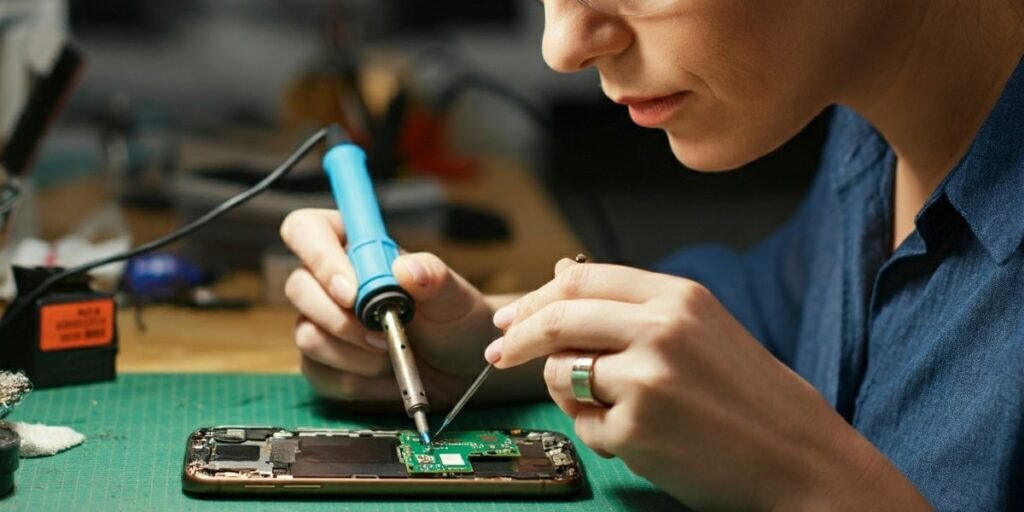The Right to Repair movement is an initiative that aims to empower consumers by granting them the ability to fix their own devices and appliances. This movement has gained traction as more people realize the challenges posed by manufacturers who often make repairs difficult or costly. This article will explore the movement’s background, current legal situation, and its implications for consumers and manufacturers alike, particularly in the context of smartphones.
Key Takeaways
- The Right to Repair movement advocates for consumers’ ability to fix their own devices, like smartphones.
- Legislation is being introduced in various countries to support consumers’ repair rights.
- Manufacturers often resist these laws, citing concerns over safety and intellectual property.
- Repairing devices can help reduce electronic waste and save consumers money.
Understanding the Right to Repair Movement

Origins and History
The Right to Repair movement began as a response to the growing trend of manufacturers making it difficult for consumers to fix their own devices. This movement argues that if you own a product, you should have the ability to repair it without facing obstacles from the manufacturer. This can be traced back to the automotive industry in the 1970s, with the passage of the 1975 Magnuson-Moss Warranty Act in the United States. This act prevented manufacturers from voiding warranties if consumers used independent repair shops or parts, laying the groundwork for the broader Right to Repair movement.
While the automotive industry provided the initial spark, the movement gained significant momentum in the early 2000s with the rise of consumer electronics. As manufacturers increasingly restricted access to repair information and parts, a grassroots movement emerged, demanding the right to fix their own devices. This led to the formation of organizations like the Repair Association (founded in 2013) and iFixit (founded in 2003), which have become key advocates for Right to Repair legislation and provide resources for consumers seeking to repair their own devices. Over the years, advocates have pushed for laws that would require companies to provide access to repair tools and information.
Key Principles and Goals
The main goals of the Right to Repair movement include:
- Access to Parts and Tools: Consumers and repair shops should be able to obtain the necessary parts and tools to fix devices.
- Repair Information: Manuals and guides should be available to help people understand how to repair their products.
- Customization: Owners should be allowed to modify their devices and install custom software.
- Design for Repairability: Manufacturers should create products that are easy to repair.
Major Advocates and Organizations
Several organizations support the Right to Repair movement, including:
- The Repair Association
- iFixit
- Public Interest Research Groups (PIRGs)
- Right to Repair Europe
These groups work to raise awareness and push for legislation that supports consumers’ rights to repair their own devices. They argue that making repairs easier can lead to a more sustainable and consumer-friendly market.
The Right to Repair movement is about empowering consumers to take control of their own devices and reduce waste in our society.
Legal Landscape of the Right to Repair
Current Laws and Regulations
In the U.S., consumers generally have the right to repair their own devices. The Magnuson-Moss Warranty Act protects buyers from warranty voids due to repairs. However, many people face challenges accessing the necessary information and parts. This is where the right-to-repair movement plays a crucial role.
Recent Legislative Efforts
Several bills have been introduced to support the right to repair. For instance, the Fair Repair Act aimed to ensure that manufacturers provide documentation, parts, and tools to independent repair shops. Unfortunately, many of these bills have stalled in Congress.
International Perspectives
Globally, the right to repair is gaining traction. Countries like France and the UK have enacted laws requiring manufacturers to provide repair information and spare parts. For example, France’s Repairability Index helps consumers choose products that are easier to fix.
The right to repair is not just a consumer issue; it’s about sustainability and reducing waste.
In summary, while the right to repair is legally supported in many areas, practical barriers still exist. The movement continues to push for better access to repair resources, ensuring that consumers can maintain their devices without unnecessary hurdles.
Impact on Consumers and Manufacturers

Benefits for Consumers
- Lower Repair Costs: With the right to repair, consumers can save money by fixing their devices instead of buying new ones.
- Increased Choices: Consumers can choose from various repair options, including independent repair shops.
- Longer Product Lifespan: Easier repairs mean products can last longer, reducing waste.
Challenges for Manufacturers
- Increased Competition: More repair options can lead to competition with manufacturers’ own repair services.
- Potential Loss of Revenue: If consumers repair their devices, manufacturers may lose out on sales of new products.
- Need for Adaptation: Companies must adapt their designs to be more repair-friendly, which can be costly.
Economic Implications
| Aspect | Impact on Consumers | Impact on Manufacturers |
|---|---|---|
| Repair Costs | Decrease | Potential Increase |
| Product Lifespan | Increase | Decrease in New Sales |
| Competition | Increase | Decrease in Market Share |
The right to repair movement is reshaping how consumers interact with their devices, pushing for a more sustainable and user-friendly approach to technology. This shift is putting pressure on giants like Apple, Samsung, and Google.
Smartphone Repairability: What You Need to Know
Common Smartphone Issues
Smartphones can face various problems that may require repair. Here are some common issues:
- Broken screens: One of the most frequent problems, often caused by drops.
- Battery issues: Batteries can degrade over time, leading to shorter usage periods.
- Software glitches: Sometimes, the software can malfunction, causing apps to crash or the phone to freeze.
Tools and Resources for DIY Repairs
If you’re considering fixing your smartphone yourself, here are some tools and resources you might need:
- Screwdrivers: A set of precision screwdrivers is essential for opening your device.
- Prying tools: These help you safely open the phone without damaging it.
- Repair guides: Websites like iFixit provide step-by-step instructions for various models.
Finding Reliable Repair Services
If DIY isn’t for you, finding a trustworthy repair service is crucial. Here are some tips:
- Check reviews: Look for customer feedback online to gauge the quality of service.
- Ask about warranties: A good repair shop should offer a warranty on their work.
- Inquire about parts: Ensure they use quality parts, as this can affect the longevity of your repair.
Repairing your smartphone can save you money and reduce e-waste. Many people believe manufacturers intentionally make repairs difficult to encourage new purchases. Understanding your options can empower you to make better choices about your devices.
Opposition to the Right to Repair
Arguments Against the Movement
Many companies argue against the Right to Repair movement for several reasons:
- Safety Concerns: They claim that only authorized technicians have the right training and tools to safely repair devices.
- Security Risks: There are fears that providing repair information could lead to misuse by criminals.
- Intellectual Property: Companies worry that sharing repair information could compromise their proprietary technology.
Lobbying Efforts by Manufacturers
Major corporations across various industries, including Apple in the technology sector and Toyota in the automotive industry, along with numerous industry groups, have actively lobbied against Right to Repair legislation. They have raised concerns about potential safety, security, and intellectual property risks associated with such laws.
Potential Risks and Concerns
While the Right to Repair movement aims to empower consumers, opponents highlight potential risks:
- Unauthorized Repairs: Repairs done by untrained individuals could lead to further damage.
- Safety Hazards: Improper repairs might create safety issues for users.
- Loss of Warranty: Many manufacturers state that unauthorized repairs could void warranties.
The debate over the Right to Repair is complex, balancing consumer rights with safety and security concerns. Understanding both sides is crucial for informed decision-making.
Future of the Right to Repair Movement
Upcoming Legislation
The Right to Repair movement is gaining momentum worldwide, with numerous regions implementing or considering legislation to empower consumers and reduce electronic waste. The European Union, for example, has recently enacted regulations that mandate repairability for specific consumer electronics. This trend signals a growing desire for greater control over personal property and a shift toward more sustainable practices.
Technological Advances
As technology evolves, so does the need for repairability. New devices, especially smartphones, are becoming more complex. However, advancements in repair-friendly designs are emerging, making it easier for consumers to fix their gadgets. This includes:
- Modular components that can be easily replaced.
- Access to repair manuals and guides.
- Tools that are user-friendly for non-experts.
Consumer Advocacy and Awareness
Consumer awareness is crucial for the Right to Repair movement. More people are realizing the importance of being able to fix their own devices. Advocacy groups are working hard to educate the public about their rights. Here are some ways consumers can get involved:
- Support local repair shops.
- Share information about repair rights on social media.
- Participate in community repair events.
The Right to Repair movement is not just about fixing things; it’s about empowering consumers to take control of their own products.
In short, the future of the Right to Repair movement hinges on legislative changes, technological innovations, and increased consumer awareness. As these elements come together, the movement is likely to gain more traction, benefiting both consumers and the environment.
Conclusion
In summary, the Right to Repair movement is all about giving you the power to fix your own devices, like smartphones. This movement is growing because many people want to keep their gadgets longer and reduce waste. With so many phones ending up in landfills each year, it’s clear that we need to change how we think about repairs. While some companies want to keep control over how their products are fixed, more people are pushing for laws that make it easier to repair devices. As we move forward, it’s important to support these changes so that everyone can have the right to repair their own technology.
Frequently Asked Questions
What is the Right to Repair movement?
The Right to Repair movement is a push for laws that let people fix their own devices or choose who repairs them. It aims to reduce waste and give consumers more control over their products.
Why is the Right to Repair important?
It’s important because many devices are hard to repair, leading to more waste. By making repairs easier, we can save money and help the environment.
Can I legally repair my smartphone?
Yes, in many places, you can repair your smartphone. However, some companies make it difficult by not sharing repair manuals or parts.
What are the benefits of repairing my smartphone?
Repairing your smartphone can save you money, extend its life, and reduce electronic waste.
Are there risks to repairing my own devices?
Yes, there can be risks like voiding warranties or damaging the device. It’s important to know what you’re doing or seek help from a professional.
What should I do if I can’t repair my smartphone?
If you can’t repair it yourself, look for a trusted repair shop or consider buying refurbished devices instead of new ones.





